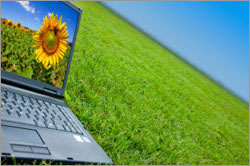What makes a 'green' laptop
 Because the clean green planet is no longer a statement of environmentalists. Technology products are also becoming more friendly, and laptops are no exception. So, what factors make a 'green' laptop?
Because the clean green planet is no longer a statement of environmentalists. Technology products are also becoming more friendly, and laptops are no exception. So, what factors make a 'green' laptop?
1. Low power consumption
Energy Star evaluates the quality of laptops at power consumption. Environmentalists care about laptop's energy consumption even when the device is in mode: standby, sleep, and operation. LED blacklit displays consume 30% less electricity than LCD monitors.
2. Use environmentally friendly materials
The materials used to manufacture laptops need to be specially paid attention to and assess the level of environmental impact. When evaluating laptops, the system evaluates the environmental friendliness of electronic products EPEAT (Electronic Product Environmental Assessment Tool) that monitor hazardous materials. Environmental organizations encourage firms not to use materials, such as cadmium, mercury, lead, hexavalent chromium, plastics, flammable substances, and PVC. In particular, laptop batteries should not contain lead, cadmium and mercury.
3. Laptop life and regeneration
If you buy a laptop and its accessories only 'live' for 6 months it is a waste. EPEAT is interested in whether the laptop can easily upgrade the accessories without the help of computer repairers. In addition, warranty issues are also taken seriously.
EPEAT requires all laptops to have a 3-year warranty period.
4. Environmentally friendly containers
Not only the new production materials contribute to the creation of green products, it is also the packaging material (containers) that also affect the environment.
According to EPEAT standards, heavy metals are not attached to laptop cases. Many manufacturers, including Apple and HP, have begun using recycled materials to build environmentally friendly computer boxes.
5. Design 'go along with the years'
Estimated, every year, Americans 'fired' more than 19 thousand laptops. Therefore, EPEAT is interested in managing laptop lifecycle. The cleanest green laptop is the one that does not have paint and coating on its plastic surface. EPEAT requires laptop manufacturers to have an additional reuse service, or user acquisition. The laptop battery should have the same service.
You should read it
- Green light from the screen of smartphone, tablet and laptop can cause blindness faster
- Apple computers were ostracized because 'not green'
- 13 ways to protect laptops that everyone needs to know
- 4 simple ways to protect your eyes when working long in front of electronic devices
- Green Bond Benefits for Proactive Investors
- 'Iron Man' Robert Downey Jr. Founder of the Alliance to clean the earth with AI and robots
- How to beat alcohol with drinks
- 8 free apps that help build an environmentally friendly lifestyle
- Beautiful Green Tree Background, download Beautiful Green Tree Background here
- How to Open a Green Car Wash
- 10 great benefits of Matcha green tea you may not know yet
- How long does it take waste to decompose?






 How to Fix the Error of Watching Videos with Green Stripes Highly Effectively
How to Fix the Error of Watching Videos with Green Stripes Highly Effectively Beautiful Green Tree Background, download Beautiful Green Tree Background here
Beautiful Green Tree Background, download Beautiful Green Tree Background here How to Open a Green Car Wash
How to Open a Green Car Wash 10 great benefits of Matcha green tea you may not know yet
10 great benefits of Matcha green tea you may not know yet Aspire 3811TZ, Acer 'green' laptop
Aspire 3811TZ, Acer 'green' laptop Laptop makes buzzing noise? What is the cause and how to fix it?
Laptop makes buzzing noise? What is the cause and how to fix it?